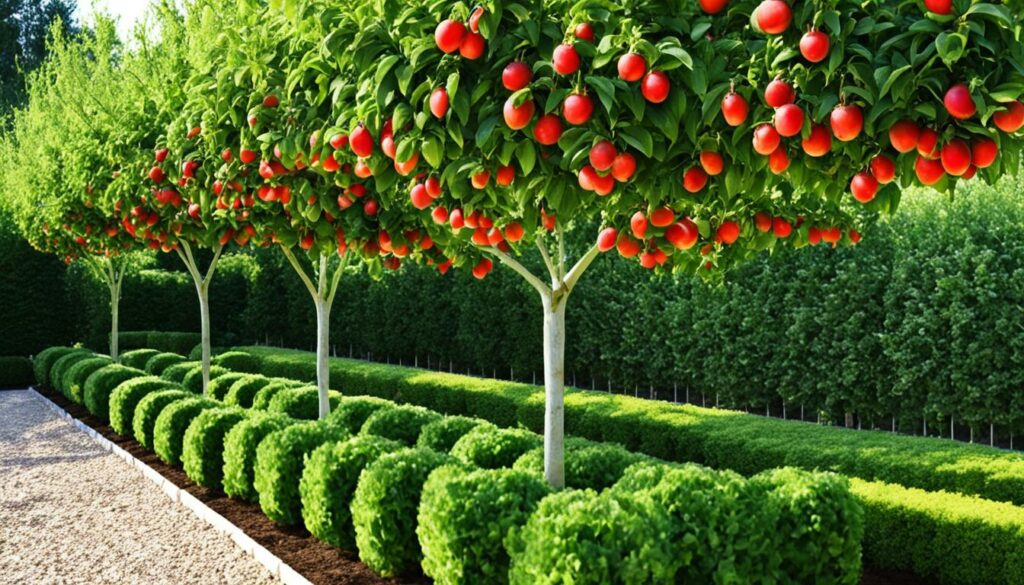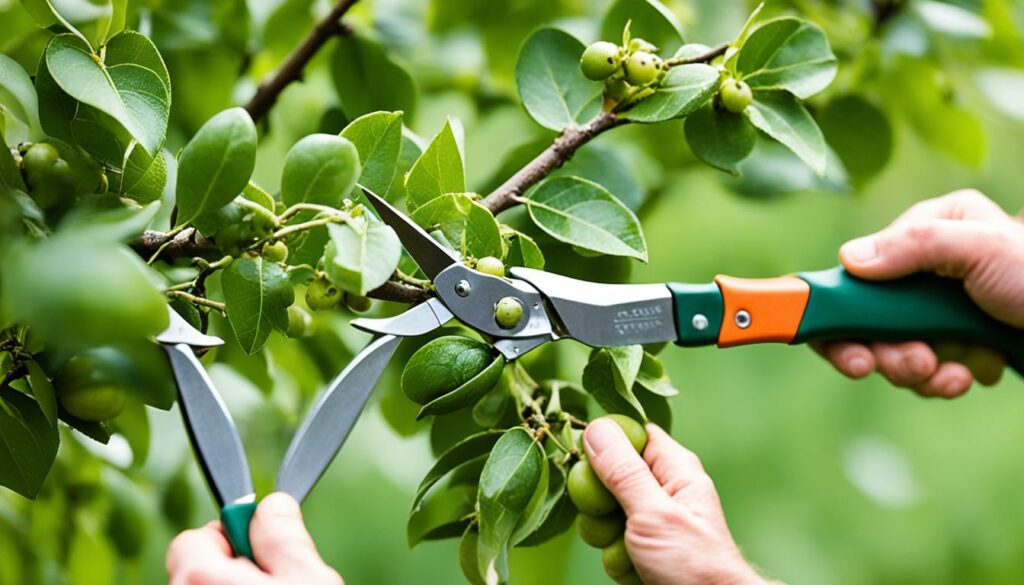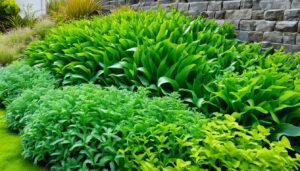In the realm of urban gardening, space is often a luxury few can afford. But what if you could transform even the smallest patio into a delightful orchard? The ancient art of espalier, with its European roots deeply planted in the bygone eras of castle gardens, might just be the trick to turn your petite green space into a realm of abundance. By training small fruit trees along flat planes against secure surfaces, you usher in a new era—a harmonious blend where nature’s bounty meets architectural grace. From the charmingly practical ‘cordon’ style for tiny terraces to the ornamental ‘lattice’ for more expansive small orchard trees, this tailored cultivation technique is a game-changer. As it unmasks the potential of patio fruit trees, miniature fruit trees, and small space fruit trees to yield a surprising harvest, the question beckons—how can you weave this botanical tapestry in your own back yard?
Embrace the challenge as we delve into the intricate dance of pruning and guiding, to craft not just fruit-laden branches, but living sculptures in your homestead. This is agriculture as you’ve never seen it before: compact, productive, and a testament to the ingenuity of gardeners past and present.
Key Takeaways
- The espalier method is an ingenious solution for cultivating fruit trees within small areas.
- Diverse shapes like cordon, fan, and lattice cater to different space constraints and aesthetic preferences.
- A variety of fruit trees, from apple to cherry, can become ornate yet practical focal points in compact gardens.
- Combining different varieties on a single dwarf stock is not only space-efficient but can extend the season of color and fruit in your garden.
- This time-honored technique is accessible for beginners, making it a fun and rewarding family project.
- The strategic combination of artistry and horticulture can turn the smallest green spaces into a verdant and productive oasis.
Understanding the Espalier Technique
The concept of espalier is rooted deeply in the tradition of space-conscious gardening, where small fruit tree varieties are meticulously trained to grow against flat surfaces. These living sculptures are not only functional, providing fruit and maximizing limited space, but they are also chosen for their aesthetic appeal. Particularly, the best small fruit trees for backyard environments are those that adapt well to training, allowing owners to cherish both beauty and bounty in their personal oases.
As an ancient practice that condenses the grandeur of an orchard into the confines of urban living spaces, espalier maximizes sunlight exposure to the fruit-bearing branches, thus encouraging better fruit quality and a more favorable harvest. This technique involves shaping the tree’s branches along wire frames or against sturdy supports, such as a wall or trellis, allowing gardeners to create various ornamental patterns.
| Training Style | Description | Ideal For |
|---|---|---|
| Horizontal Cordon | Branches trained to extend horizontally from the main trunk | Apple, Pear |
| Fan Shape | Branches splayed out in a fan-like shape | Peach, Cherry |
| Belgian Fence | Series of V-shaped patterns intertwined | Plum, Apricot |
The practice of training fruit trees in the espalier fashion not only suits the home gardener but brings a sense of historical elegance to the modern landscape. By adopting the espalier technique, even the smallest backyards can delight in the pleasure of fresh, home-grown fruits throughout the season.
Small Fruit Trees: Ideal Candidates for Espalier
When envisioning a lush backyard oasis in compact spaces, the idea of integrating fruit trees can seem like a distant dream. However, the age-old technique of espalier transforms this dream into a feasible reality, allowing garden enthusiasts to cultivate a variety of compact fruit trees even in limited spaces. The key to unlocking this green paradise is selecting the appropriate small fruit tree varieties that are amenable to espalier methods.

Choosing the Right Fruit Trees for Compact Areas
The quest for the best small fruit trees for backyard espalier begins with identifying dwarf fruit trees or semi-dwarf cultivars known for their constrained growth habits. Such trees allow gardeners to maximize their space and grow multiple varieties in a small orchard setup. Notable for their suitability are the spur-type apple varieties, such as ‘Macintosh’ and ‘Golden Delicious’. These apple cultivars are celebrated for their horizontal growth tendencies, which marry well with horizontal cordon espalier styles.
Pros and Cons of Dwarf vs. Full-Sized Varieties
There is an undeniable charm in nurturing dwarf fruit trees in a backyard setting, primarily for their space-saving attributes and less daunting maintenance. These miniature titans are the premier choice for intimate garden spaces, but they may not be small enough for every scenario. Conversely, full-sized trees can be trained with espalier techniques but require a steadfast commitment to pruning and a long-term vision to achieve the desired aesthetic.
The Role of Grafting in Espalier
The art of espalier is enhanced through grafting, a horticultural marvel that gives rise to grafted espaliers. This inventive process allows a single dwarf rootstock to play host to multiple fruiting branches, offering an extended blossom and bounty window. The resulting “fruit salad” trees not only captivate the eyes but also make for a diverse and prolonged fruiting season. Selecting compatible varieties for cross-pollination or simply to indulge in a novel fruit assortment is crucial for the thriving of these grafted wonders.
Creating Your Espalier: Planting and Training Basics
Learning how to plant an espalier begins with choosing a youthful plant that showcases potential for your espalier design. Carefully remove any extraneous branches that don’t fit your intended pattern. A strong, yet flexible support system is imperative.
“Utilize a pre-existing structure or construct one specifically for your espalier. Guide the plant’s growth using soft ties, like foam wire, ensuring no harm comes to your developing fruit tree.”

The optimal time to plant is during dormancy, typically found in the late winter or early spring months. This ensures that your small fruit tree focuses energy on root development rather than foliage or fruit. Finding a sunny spot with well-draining soil will give your espalier the foundation it requires to thrive. Espalier maintenance necessitates dedication to pruning fruit trees to retain the design, a practice which should be conducted regularly with precision.
- Position the tree against a sunny, south-facing wall or fence for maximum sunlight exposure.
- Soil should be rich and well-drained to prevent waterlogging which can damage roots.
- Use a trellis or wiring system spaced approximately 15 inches apart to support branches.
- Commence pruning early to shape the tree and continue with monthly trimming sessions.
- Maintaining a balance of growth and fruit production is key for small fruit trees.
As your espalier matures, the framework of branches will form the desired pattern, be it horizontal, vertical, or angled. Patience is critical, and with time, your espalier will not only serve as a functional fruit producer but also as a striking garden feature.
| Season | Key Activities | Notes |
|---|---|---|
| Winter | Planting and initial pruning | Ensure trees are dormant for better establishment |
| Spring | Continue light pruning and training | Focus on directing growth; monitor for pests as temperatures rise |
| Summer | Regular maintenance pruning | Key time for shaping; tie new growth as needed |
| Fall | Prepare for dormancy, assess structure | Remove any dead or diseased wood; ready the tree for winter rest |
Fostering a stunning espalier demands persistence and care, yet the result is undeniably rewarding; a bountiful harvest from even the most compact of garden spaces.
Conclusion
The artful practice of espalier represents more than just a method to train fruit trees; it embodies a confluence of aesthetic allure and utilitarian design. For those with small gardens, it presents a viable option to merge ornamental beauty with the productivity of small fruit trees. By selecting suitable varieties and investing time in proper planting and meticulous pruning, cultivators can transform basic trees into elaborate and fruitful displays — a harmonious blend of form and function.
This thoughtful approach to small space fruit trees not only enhances the visual charm of a landscape but also capitalizes on every inch of valuable garden real estate. With diligent care and maintenance, a robust espalier tree can become a focal point of both pride and practicality. Patience is indeed a requisite companion in this endeavor, as it takes steady hands and a strategic mind to sculpt these living sculptures.
In essence, espalier is more than horticultural technique; it is an ongoing relationship between gardener and nature. Each season, through the gentle guidance of the gardener’s hand, the espaliered trees are coaxed into works of art that yield sweet and sustainable rewards. This creative crafting ensures that even in the confines of limited space, the joys and satisfactions of gardening can flourish abundantly.








